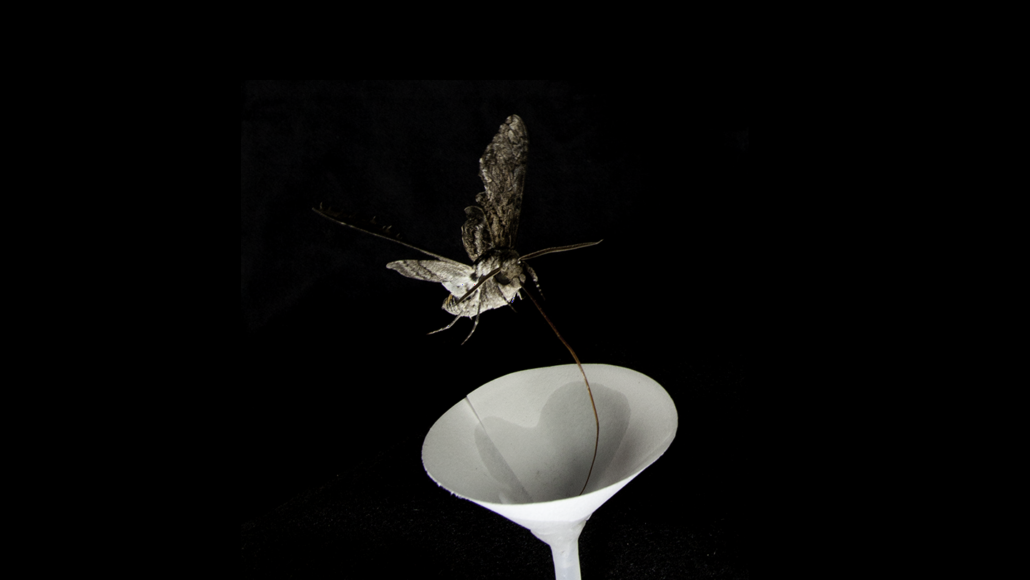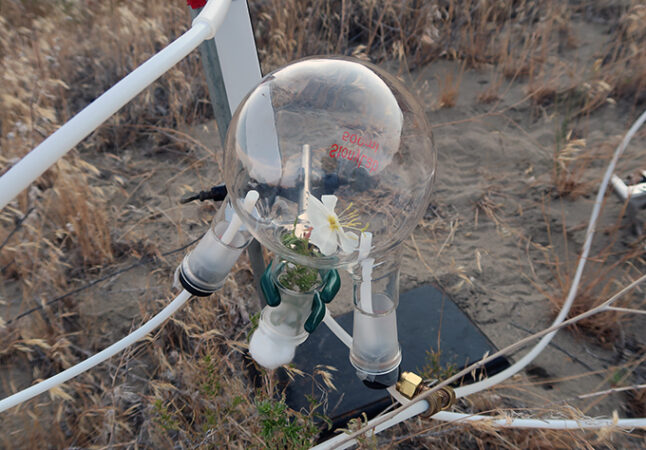Air pollution can make it harder for pollinators to find flowers
Certain pollutants break down scent molecules, robbing a primrose of its fragrance

Here, a moth visits a fake flower emitting the scent of a flower it pollinates. Nighttime air pollutants may break down a bloom’s alluring fragrance, making it harder for pollinators to find it.
Charles Hedgcock/University of Washington, Seattle
Air pollution may rob some night-blooming flowers of their signature scent, researchers show. This could make it hard for pollinators to find the blooms.
Researchers at the University of Washington in Seattle conducted field and lab tests with the pale evening primrose (Oenothera pallida). When the fragrance of its blooms interacts with certain air pollutants that build up at night, key scent molecules are destroyed.
The result: Moths and other nighttime pollinators may find it hard to recognize the blooms they were seeking.
This affects plants that depend on pollinators for reproduction. Indeed, pollination is important to food growers, notes Joel Thornton. He’s an atmospheric scientist on the team. As such, he says, pollution could pose a new type of threat to farming.
The Seattle team shared its findings February 8 in Science.

Educators and Parents, Sign Up for The Cheat Sheet
Weekly updates to help you use Science News Explores in the learning environment
Thank you for signing up!
There was a problem signing you up.
A radical discovery
For millions of years, bees, birds and other pollinators have used scent to locate flowers for nectar. As they stop at a plant, they can pick up some of its pollen and transfer it to any flowers they later visit.
But those scent cues may be changing. Today, traffic, industries and other human activities spew pollution into the air. These chemicals include ozone and nitrogen oxides. By day, sunlight tends to break down much of the ozone. But in the dark, ozone can build up. As it does, it reacts with nitrogen dioxide in the air. That produces short-lived but highly reactive chemicals called nitrate radicals.
Scientists knew such reactive pollutants could change plant scents. But details of this process and its impacts were unclear. Now, the Seattle-based team has shown that nitrate radicals can alter some of the floral scents that attract insects.
Ecologist Jeremy Chan put bags over pale evening primrose blooms to trap the flowers’ scent. (Chan was part of the research team but now works in Italy at the University of Naples Federico II.) He took the scent back to the lab, along with some hawkmoths. Hawkmoths are one of the pollinators drawn to the primrose’s scent.
In the lab, the team designed a wind tunnel that could mimic conditions in an outdoor field (including air temperature and pressure). Then they released the primrose scent and hawkmoths into the air flowing into this wind tunnel. At once, they watched the moths “easily flying upwind and tracking the odor,” says Jeff Riffell. He’s a biologist on the University of Washington team.
But it was a different story when pollutants, like ozone and nitrogen dioxide, were added to the mix. Now, the moths flew in a zigzag or wavy line. They seemed to be seeking the scent — often without success.
Tracking down the moth’s problem
The team then identified the molecules, one by one, that make up the floral scent. Moths use their antennae to detect scents. So the researchers exposed a moth antenna to each chemical. Two chemicals created an especially strong response. This suggested they were the most important scent cues the moths use to find primrose blooms. Both chemicals were monoterpenes (Mon-oh-TER-peens), a type of scented oil. Plants often produce these oils to attract pollinators.
When nitrate radicals bump into these compounds, the monoterpenes broke into pieces. This erased most of the bloom’s allure. The effect is essentially like “blindfolding you and asking, ‘Can you go and get me a coffee?’” says Jose Fuentes. He’s an atmospheric scientist at Pennsylvania State University in State College who did not take part in the new work.
To Riffell: “It was surprising [that] a seemingly subtle change in concentration of only two compounds — out of more than 20 — was sufficient” to do this.

The team then decided to test its findings in nature. One chilly night, Chan drove 280 kilometers (175 miles) east of campus and set up a field of fake and real flowers. His team used white paper to craft small funnels. They were roughly the same size and shape as pale evening primrose blooms.
In some of the fake flowers, a tiny tube snaked around what looked like a fake bud. This tube released a mist of lab-made primrose fragrance to mimic real flowers. Tubes in others also released chemicals that reacted to make nitrate radicals. Chan then set up cameras to record how many moths visited the fake flower buds.
Moths usually visited the flowers — fake or real — that emitted the primrose scent. They’d stop by two or three times a night. But where this scent was mixed with the pollutants, moth visits dropped. On average, there was a little more than one nightly visit for every two flowers. Some moth species never found a single flower during the tests.
Do you have a science question? We can help!
Submit your question here, and we might answer it an upcoming issue of Science News Explores
The same reactions could hurt floral scents by day. But because sunlight can break down ozone, the problem is likely more of a problem for night pollinators.
Warmer air tends to cook up higher levels of ozone and certain other air pollutants from the gases and particles emitted by combustion. As Earth’s climate warms, it’s likely that a mix of pollutants like ozone, nitrogen dioxides and nitrate radicals will continue to climb. Such conditions could worsen the pollution threat to floral scents and plant pollination, says Fuentes of Penn State.
That’s the reason “we need to learn how these [pollutants] are impacting foraging and flower visits of pollinators,” he says. Confusing pollinators, he says, can reduce the health — and yield — of farm crops. And, he adds, it could hurt the reproduction of native plant species, too.







